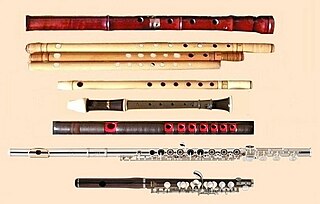
The flute is a member of a family of musical instruments in the woodwind group. Like all woodwinds, flutes are aerophones, producing sound with a vibrating column of air. Unlike woodwind instruments with reeds, a flute produces sound when the player's air flows across an opening. In the Hornbostel–Sachs classification system, flutes are edge-blown aerophones. A musician who plays the flute is called a flautist or flutist.
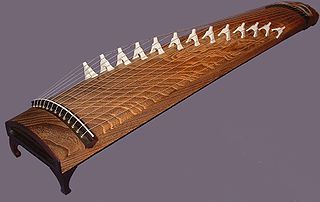
The koto is a Japanese plucked half-tube zither instrument, and the national instrument of Japan. It is derived from the Chinese zheng and se, and similar to the Mongolian yatga, the Korean gayageum and ajaeng, the Vietnamese đàn tranh, the Sundanese kacapi and the Kazakh jetigen. Koto are roughly 180 centimetres (71 in) in length, and made from Paulownia wood. The most common type uses 13 strings strung over movable bridges used for tuning, different pieces possibly requiring different tuning. 17-string koto are also common, and act as bass in ensembles. Koto strings are generally plucked using three fingerpicks, worn on the first three fingers of the right hand.

The ocarina is a wind musical instrument; it is a type of vessel flute. Variations exist, but a typical ocarina is an enclosed space with four to twelve finger holes and a mouthpiece that projects from the body. It is traditionally made from clay or ceramic, but other materials are also used, such as plastic, wood, glass, metal, or bone.

A shakuhachi is a Japanese longitudinal, end-blown flute that is made of bamboo. The bamboo end-blown flute now known as the shakuhachi was developed in Japan in the 16th century and is called the fuke shakuhachi (普化尺八). A bamboo flute known as the kodai shakuhachi or gagaku shakuhachi (雅楽尺八) was derived from the Chinese xiao in the Nara period and died out in the 10th century. After a long blank period, the hitoyogiri shakuhachi (一節切尺八) appeared in the 15th century, and then in the 16th century, the fuke shakuhachi was developed in Japan. The fuke shakuhachi flourished in the 18th century during the Edo period, and eventually the hitoyogiri shakuhachi also died out. The fuke shakuhachi developed in Japan is longer and thicker than the kodai shakuhachi and has one finger hole less. It is longer and thicker than hitoyogiri shakuhachi and is superior in volume, range, scale and tone quality. Today, since the shakuhachi generally refers only to fuke shakuhachi, the theory that the shakuhachi is an instrument unique to Japan is widely accepted.
Gagaku is a type of Japanese classical music that was historically used for imperial court music and dances. Gagaku was developed as court music of the Kyoto Imperial Palace, and its near-current form was established in the Heian period (794–1185) around the 10th century. Today, it is performed by the Board of Ceremonies in the Tokyo Imperial Palace.

A bansuri is an ancient side blown flute originating from India and Nepal. It is an aerophone produced from bamboo and metal like material used in many nepali lok songs. A bansuri is traditionally made from a single hollow shaft of bamboo with seven finger holes. Some modern designs come in ivory, fiberglass and various metals. The six hole instrument covers two and a half octaves of music. The bansuri is typically between 30 centimetres (12 in) and 75 centimetres (30 in) in length, and the thickness of a human thumb. One end is closed, and few centimeters from the closed end is its blow hole. Longer bansuris feature deeper tones and lower pitches. The traditional design features no mechanical keys, and the musician creates the notes they want by covering and uncovering the various finger holes.
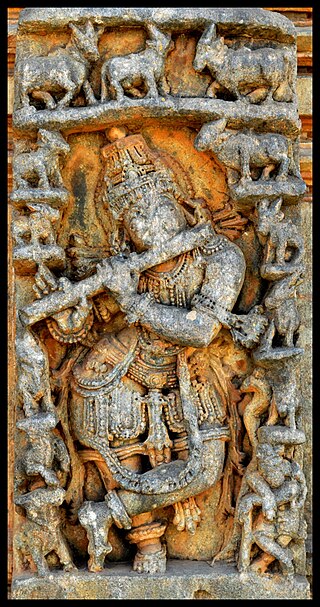
The bamboo flute, especially the bone flute, is one of the oldest musical instruments known. Examples of Paleolithic bone flutes have survived for more than 40,000 years, to be discovered by archaeologists. While the oldest flutes currently known were found in Europe, Asia too has a long history with the instrument that has continued into the present day. In China, a playable bone flute was discovered, about 9000 years old.
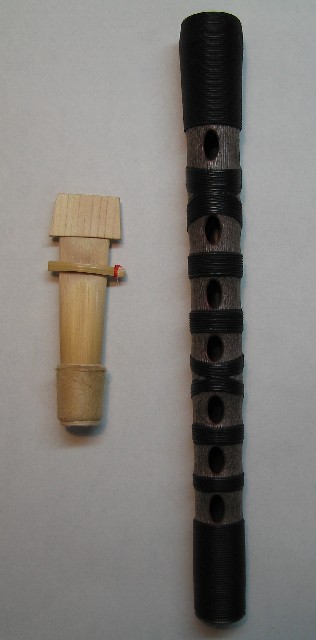
The hichiriki (篳篥|筚篥) is a double reed Japanese fue (flute) used as one of two main melodic instruments in gagaku music. It is one of the "sacred" instruments and is often heard at Shinto weddings in Japan. Its sound is often described as haunting.

Toshi Ichiyanagi was a Japanese avant-garde composer and pianist. One of the leading composers in Japan during the postwar era, Ichiyanagi worked in a range of genres, composing Western-style operas and orchestral and chamber works, as well as compositions using traditional Japanese instruments. Ichiyanagi is known for incorporating avant-garde techniques into his works, such as chance music, extended technique, and nontraditional scoring. Ichiyanagi was married to artist Yoko Ono from 1956 to 1962.
Tōgaku is the Japanese pronunciation of an early style of music and dance from the Tang Dynasty in China. Tōgaku was introduced into Japanese culture from China no earlier than the 8th century, and is still performed as one style of the imperial court music called gagaku.
During the Nara period (710–794), music and dances continued to flow into the capital from many parts of Asia. Many styles were eventually organized under two basic categories of gagaku. The first, tōgaku, consisted of pieces of Chinese and Indian origin, while komagaku included Manchurian, Korean, and many of the Japanese pieces. These two styles can be distinguished by their instrumentations.
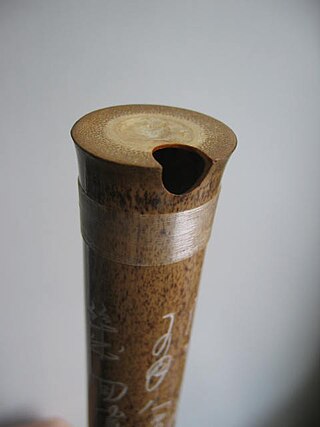
The xiao is a Chinese vertical end-blown flute. It is generally made of bamboo. It is also sometimes called dòngxiāo, dòng meaning "hole." An ancient name for the xiāo is shùzhúdí but the name xiāo in ancient times also included the side-blown bamboo flute, dizi.
In music, fingering, or on stringed instruments sometimes also called stopping, is the choice of which fingers and hand positions to use when playing certain musical instruments. Fingering typically changes throughout a piece; the challenge of choosing good fingering for a piece is to make the hand movements as comfortable as possible without changing hand position too often. A fingering can be the result of the working process of the composer, who puts it into the manuscript, an editor, who adds it into the printed score, or the performer, who puts his or her own fingering in the score or in performance.
Fingering...also stopping...(1) A system of symbols for the fingers of the hand used to associate specific notes with specific fingers....(2)Control of finger movements and position to achieve physiological efficiency, acoustical accuracy [frequency and amplitude] and musical articulation.
The Nohkan is a high pitched, Japanese transverse bamboo flute, or fue. It is commonly used in traditional Imperial Noh and Kabuki theatre. The nohkan flute was created by Kan'ami and his son Zeami in the 15th century, during the time when the two were transforming the Noh theatre forms Dengaku and Sarugaku.
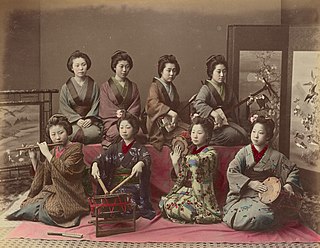
Traditional Japanese musical instruments, known as wagakki (和楽器) in Japanese, are musical instruments used in the traditional folk music of Japan. They comprise a range of string, wind, and percussion instruments.
The komabue (高麗笛) is a transverse bamboo flute, a fue that is used in traditional Japanese court music.
Etenraku is a Japanese gagaku melody and dance. It is usually played with a hichiriki or ryūteki, and is accompanied by other traditional instruments such as the shō, koto and kakko.

A yokobue (横笛) is a Japanese transverse flute or fue. The various types include the Komabue, Nōkan, Ryūteki, and Shinobue.
The Shakubyoshi (kanji: 笏拍子; is a Japanese musical instrument consisting of two wooden slabs that are struck together. It is the oldest Japanese percussion instrument and is used to keep time in ancient genres tied to gagaku. Its dimensions are 36 centimetres in length, 2.4 centimetres in width at the base, 3.9 centimetres at the tip and 1 centimetre thickness on average. It is held at the base.

Gagaku & Beyond is an album by jazz flautist Herbie Mann featuring shakuhachi player Minoru Muraoka which was recorded in Japan in 1974 but only released on Atlantic Records' subsidiary label, Finnadar, in 1976.
The Limbe is a western concert flute with six finger holes from Mongolian folk music, which belongs to the nomadic pastoral culture and is usually played with circular breathing by experienced players. The continuous playing of the flute to accompany "long songs" lasting up to 25 minutes was added to the UNESCO Intangible Cultural Heritage Lists in urgent need of preservation in 2011. Like most other Mongolian musical instruments, the limbe is traditionally only allowed to be played by men. The origin of the East Asian flutes such as the limbe and the related dizi in China could be traced back to the 1st millennium BC.












